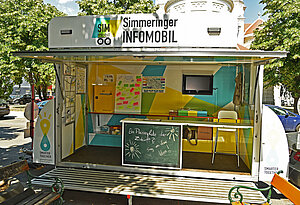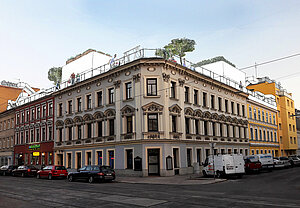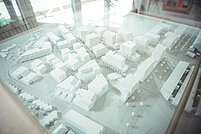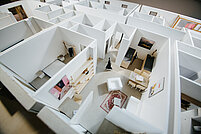HOW WILL WE LIVE TOMORROW? - Developing Existing Housing Stock
Exhibition tour part 5 of 5
Urban renewal in Vienna is closely associated with areas shaped by the Gründerzeit. However, in the coming years, the further development of existing neighborhoods from the 1950s to the 1970s will become increasingly important. This requires new approaches that go far beyond structural renewal. Innovative technologies in building renovation, climate-friendly energy systems, sustainable mobility offerings, and comprehensive participation are fields of action that need to be addressed at the neighborhood level. The success of this "new" urban renewal depends not least on a broadly supported development vision. What are successful innovations in the areas of redevelopment methods, energy generation and use, and mobility offerings? And which of these innovations has reached feasibility limits? How can acceptance for interventions in existing buildings be achieved through dialog and participatory formats? Which actors need to pull together to achieve this?
Per-Albin-Hansson-Siedlung
With a total of over 6,000 flats, Per-Albin-Hansson-Siedlung is one of the largest municipal housing estates in Vienna. Current development challenges arise from demographic, infrastructural and social needs. How can a large urban settlement be made fit for the future and adapted to today's housing needs?
There are many small and large works of art in the Per-Albin-Hansson-Siedlung. Here you can download the art guide of the Per-Albin-Hansson-Siedlung directly.
Smarter Together
Smarter Together is the joint smart city lighthouse project of Vienna, Munich and Lyon. It was funded by the EU as part of the Horizon 2020 research programme. In selected city districts, technical and social innovations as well as innovative processes are now making contributions to sustainable urban renewal. These also contribute to achieving the UN climate goals. In addition, impulses for a positive social dynamic could also be set on a meta-level. The project comprises a three-year implementation phase (2016-2019) and a subsequent monitoring and evaluation phase (until 2021).
G'mischter Block
Based on the Masterplan Gründerzeit, substantial and previously underused parts of a Gründerzeit block in the 10th district will be redeveloped here.
Apfelbaum
Apfelbaum is a visionary real estate project. It offers a counter-model to exclusion and displacement and focuses on inclusion as a social attitude.
Pocket Mannerhatten
Those who share get more - this is the principle on which Pocket Mannerhatten is based: Neighbouring properties exchange rights of use, share areas and spaces and thus tap additional potential. This has advantages for the entire city quarter.
Further exhibition elements
Audio-Stories
Audio-Stories
Stories were recorded for all IBA neighbourhoods as part of the Interim Presentation. Please note, the audio-stories are in German only.
Architectural models
Architectural models play an essential role in the planning process, as they make ideas and concepts visible and tangible. In the exhibition "How will we live tomorrow?" the models were therefore an important building block to enable a holistic view of the project.





![[Translate to English:] Drohnenflug (c) IBA_Wien/ J. Stehno](/fileadmin/_processed_/2/7/csm_IMG_20200507_103126_8de9e6e6fb.jpg)
![[Translate to English:] Audio (c) IBA_Wien/ L. Schedl](/fileadmin/_processed_/f/b/csm_004_20200904__c_Schedl_IBA_e6ecb00386.jpg)
![[Translate to English:] Postkarten (c) IBA_Wien/ L. Schedl](/fileadmin/_processed_/0/2/csm_20200908-_DSC0798-_Wohnpartner_02a63864a3.jpg)
















